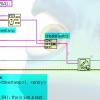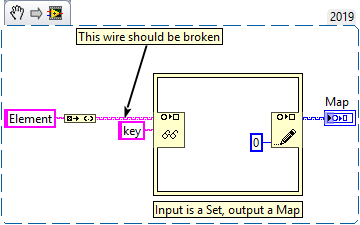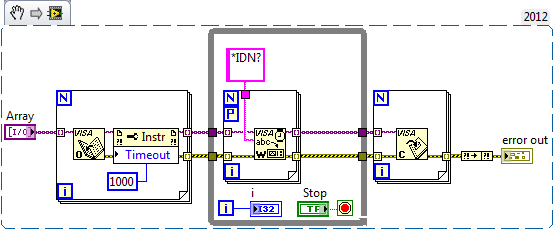Search the Community
Showing results for tags 'crash'.
-
I can very repeatedly hang LabVIEW 2017 without even running a VI. It involves simply changing the y-scale mapping on a graph to be logarithmic. The best I can tell is that the initial (linear) scaling has the same max/min range values and this causes the problem somehow. Does this happen in other versions of LabVIEW? (I'm using 17.0.1.f4, 64-bit.) And more importantly, how can I avoid this issue if I want to use log scaling and the data may start with a bunch of identical (positive-definite) values? I'm using the "XY Graph (silver)" control. I haven't yet replicated the problem with the standard "XY Graph" control, either because I haven't created the right conditions or because that control doesn't have the issue. But I'd like to avoid switching out all my (many) graphs, in any case. CrashDemo.vi
-
I discovered a potential memory corruption when using Variant To Flattened String and Flattened String To Variant functions on Sets. Here is the test code: In this example, the set is serialized and de-serialized without changing any data. The code runs in a loop to increase the chance of crashing LabVIEW. Here is the type descriptor. If you are familiar with type descriptors, you'll notice that something is off: Here is the translation: 0x0008 - Length of the type descriptor in bytes, including the length word (8 bytes) => OK 0x0073 - Data type (Set) => OK 0x0001 - Number of dimensions (a set is essentially an array with dimension size 1) => OK 0x0004 - Length of the type descriptor for the internal type in bytes, including the length word (4 bytes) => OK ???? - Type descriptor for the internal data type (should be 0x0008 for U64) => What is going on? It turns out that the last two bytes are truncated. The Flatten String To Variant function actually reports error 116, which makes sense because the type descriptor is incomplete, BUT it does not always return an error! In fact, half of the time, no error is reported and LabVIEW eventually crashes (most often after adding a label to the numeric type in the set constant). I believe that this corrupts memory, which eventually crashes LabVIEW. Here is a video that illustrates the behavior: 2021-02-06_13-43-58.mp4 Can somebody please confirm this issue? LV2019SP1f3 (32-bit) Potential Memory Corruption when (de-)serializing Sets.vi
-
Here is another bug I discovered in LV2019+ which reliably crashes LV. Simply connect a set to the map input of the Map Get / Replace Value node on the IPE: This VI is executable in LV2019 SP1 f3, which means that you can actually build that into an executable without noticing. I have reported this, but there is no CAR yet.
-
Hi, My LabVIEW 2016 32 bit is crashing a lot. I can guess it is related to: 1. incompatibility with DAQmx 9.1.5 and the related device driver which I need for LabVIEW 8.5.1 which I also use (NI's support jumped on that issue yet I think it is not related) 2. an addon that I use to access OpenCV leaving some references open in the dlls 3. Controls with same label or with no label (I believe that this is the issue -LV can't recover correctly in such cases) However, I don't want to guess like NI's support that it is point 1 and do nothing to prove it. I expect to see the reason in a log file yet the support wasn't able to show me where to find it. Searching around I found the dmp file under documents\LabVIEWdata Is that the way to check those crashes or one of you know of a better way to check it beside elimination? Thanks in advance
- 11 replies
-
Hey y'all, Wanted to look for some feedback on some code I made for troubleshooting crashes and hangs for medium to large LabVIEW applications. Wanted a way for a user experiencing a crash/hang to have a simple way of narrowing down where the problem is occurring. The VI is named Crash Logger.vi and it only requires the VI itself to use. No type def's, additional VI's, or other necessary parts. The reason for this is so that a user can drop it in multiple parts of their application and have it log the current state and some information on system state to narrow down where a crash/hang is occurring. I've gotten some feedback from friend's regarding making it a global variable that wrote to variables and had a separate VI to do the logging, but this takes away the "ease of use" I am going for for the user. I've included an example application to show how it can be used for a simple state machine. I'd love getting more insight into what I could do better though which is why I'm coming here! Let me know what y'all think! - Bear Crash Logger Project and VI.zip Crash Logger.vi
- 9 replies
-
- crash
- troubleshooting
-
(and 1 more)
Tagged with:
-
Hi everyone. I wrote wrapper in Visual Studio for OpenCV calibrateCamera() function. Every operation like converting 1D array of points to vector<vector<Point2f>> etc, works ok, except most important thing. When function ()calibrateCamera is called, LabVIEW crashes. When this line is commented out, dll works ok (at least labview is still alive). Im out of ideas. I suspect that this is problem with memory management but i dont have an idea where it cames from. Function do not operate directly on data passed from LabVIEW. Ultimately I can compile code as exe and call it via cmd, but I'm curious why such a thing appears. Thanks for your precious time! Zyga dll source (if you need i can enclose some sample input data): #include <opencv2/core/core.hpp> #include <opencv2/calib3d/calib3d.hpp> #include <extcode.h> using namespace cv; using namespace std; static void calcBoardCornerPositions(Size boardSize, float squareSize, vector<Point3f> &corners); static void arr2vect(float *APoints,int *Asize, vector<vector<Point2f>> &imagePoints); extern "C" { float __declspec(dllexport) Calibrate(float *APoints, int *Asize, int width, int height, float squareSize) { //initialize variables vector<vector<Point2f>> imagePoints; Size boardSize; boardSize.height = height; boardSize.width = width; Mat cameraMatrix = Mat::eye(3, 3, CV_64F), distCoeffs = Mat::zeros(1, 1, CV_64F); cameraMatrix.at<double>(0,0) = 1.0; vector<Mat> rvecs, tvecs; vector<vector<Point3f>> objectPoints(1); Size imageSize; imageSize.width = 2040; imageSize.height = 2040; arr2vect(APoints, Asize, imagePoints); // prepare imagePoints calcBoardCornerPositions(boardSize, squareSize, objectPoints[0]); //prepare objectPoints objectPoints.resize(imagePoints.size(),objectPoints[0]); //calibrate double rms = calibrateCamera(objectPoints, imagePoints, imageSize, cameraMatrix, distCoeffs, rvecs, tvecs); return rms; } } //definitions static void arr2vect(float *APoints,int *Asize, vector<vector<Point2f>> &imagePoints) { int page = *(Asize); int row = *(Asize+1); int col = *(Asize +2); Point2f pointBuf; vector<Point2f> vectBuf; for (int i = 0; i<page; i++) { for (int j = 0; j<row; j++) { pointBuf.x = *(APoints + (i*(row*col))+j*2); pointBuf.y = *(APoints + (i*(row*col))+j*2+1); vectBuf.push_back(pointBuf); } imagePoints.push_back(vectBuf); vectBuf.clear(); } vectBuf.clear(); } static void calcBoardCornerPositions(Size boardSize, float squareSize, vector<Point3f> &corners) { corners.clear(); for( int i = 0; i < boardSize.height; ++i ) for( int j = 0; j < boardSize.width; ++j ) corners.push_back(Point3f(float( j*squareSize ), float( i*squareSize ), 0)); }
-
Hi, I have several USB instruments (Agilent/Keysight optical power meters) which I can talk to via USB. To minimise the time "wasted" by transferring data between the instruments and the PC I would like to query them in parallel. Unfortunately, LabVIEW doesn't agree with that strategy and reliably crashes when doing so. It doesn't matter which command I send, so here's a sample snippet, where I just query the instrument ID repeatedly. I don't even have to read the answer back (doing so won't make a difference): This will kill LabVIEW 2012 and 2014, both 64bit without even popping up the "We apologize for the inconvenience" crash reporter dialog. Has anyone had similar experiences? I've seen LabVIEW crash while communicating over RS232 (VISA) but it's much harder to reproduce. Is it outrageous to assume that communication to separate instruments via different VISA references should work in parallel? All my instrument drivers are separate objects. I can ensure that communication to a single type of instrument is done in series by making the vi that does the communication non-reentrant. But I have to communicate with multiple instruments of different types, most of which use some flavour of VISA (RS232, USB, GPIB). Am I just lucky that I haven't had more crashes when I'm talking to a lot of instruments? Could it be a bug specific to the USB part of VISA? I've only recently changed from GPIB to USB on those power meters to get faster data transfer rates. In the past everything went via GPIB, which isn't a parallel communication protocol anyway afaik. Tom
-
Hi all ! Currently building a TS custom interface for one of my customer, I decided (this time) to manage user rights directly using TS user manager. Since I applied this solution, LV randomly crashes (or not crash) without giving any message that could help on resolving the issue. This is not the first time I create TS custom interfaces, but this time there are few new things compared to other HMI I built : newer LV | TS versions than usually (LV 2011 SP1.f2 and TS 2010 SP1.f1) user rights are managed using TS user manager For my user manager, I used a functional global to retain the TS engine reference and share through all functions I made to deal with user (I've built a library in order to reuse these functions later). Maybe this is not allowed... what do you think about it ?
-
I have posted on the NI forum (here) but didn't get any response sine 5 days. I have came across a nasty bug that caused Labview 2010 SP1 (Running Win 7 Ultimate x64 bit) to crash without any warning. To replicate the bug do the following: Add a numeric control and another indicator to the front panel Switch to block diagram and add a feed back node Connect the initializer terminal of the feed back node to the output of the control Now do ANY of the following to cause the bug: Press the run button (which is broken due to not connecting the input of the feed back node) it will turn to a normal run without displaying the error Do an extra action and undo it, the run button will turn from list error normal So far the Vi can be saved normally. Now connect the output of the feed back node to the indicator and try any of the followings: Save the VI Close the VI Create a new project and select to add the VI to the project This will cause Labview to crash without any notice! When you are at step 4, the bug is there but harmless. Once you combine it with step 5 (connect to indicator), the bug is active and cause crashing. I have attached a snapshot of how the Front panel/block diagram look like before saving (since it can't be saved). Notice how the run button is enabled although the input of the feedback node is not connected. I have tried to replicate the error on Labview 2009 but couldn't.


PotentialMemoryCorruptionwhen(de-)serializingSets.png.e31ac61a8ef3ee1d71ad471d67565015.png)








